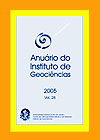Microphysical structure of clouds in different ecosystems of South America
DOI:
https://doi.org/10.11137/2009_2_33-41Abstract
Clouds directly affect meteorological conditions of the planet, by interacting with electromagnetic radiation from the sun, the earth's surface and the atmosphere. Each cloud type interacts in a particular way, being extremely important that the total set of clouds at any location is well represented in atmospheric models, in order to generate more accurate results. The purpose of this paper is to initiate a characterization of cloud types as a function of their microphysical properties and evaluate the dependence on ecosystem and synoptic condition. The data were obtained through remote sensing, using the MODIS sensor and the variables: cloud particle effective radius, optical thickness, pressure and temperature of the cloud top. Several forms of distributions were found for six different ecosystems for the four seasons. It was noted that narrow and concentrated effective radius spectra are linked to deep convection clouds, while broader distributions can be usually associated to cold frontal systems. The amount of events analyzed was not enough to show clear patterns, although the results can lead to other directions in a future and more focused work.Downloads
Download data is not yet available.
Downloads
Published
2009-12-01
How to Cite
Duarte, B. M. and França, J. R. de A. (2009) “Microphysical structure of clouds in different ecosystems of South America”, Anuário do Instituto de Geociências. Rio de Janeiro, BR, 32(2), pp. 33–41. doi: 10.11137/2009_2_33-41.
Issue
Section
não definida
License
This journal is licensed under a Creative Commons — Attribution 4.0 International — CC BY 4.0, which permits use, distribution and reproduction in any medium, provided the original work is properly cited.















